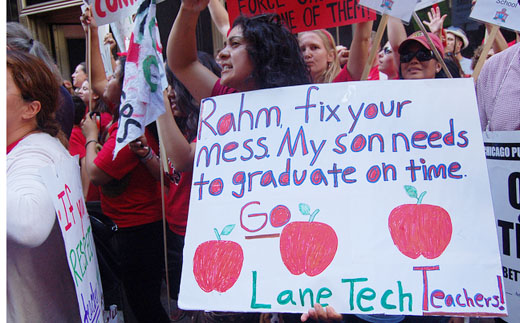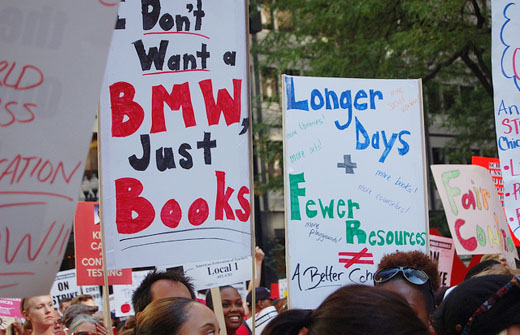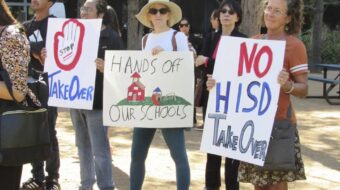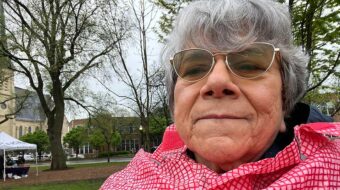
It was nine days that shook Chicago – and the nation. Twenty-five thousand public school teachers, guidance counselors, speech-language pathologists, social workers, nurses and other professionals, members of Chicago Teachers Union Local 1, stood up and said with one voice, “Enough!”
Left with no other choice by an intransigent Board of Education and a politically ambitious mayor, teachers took to the picket line, declaring that the strike was for the kids, the profession and public education everywhere. This was a strike that changed the city.
This red sea would not be parted
For those nine days, the city went red, symbolizing solidarity with the union. Mass protests felt like festivals with clever, and often funny signs (Rahm likes Nickelback), musicians – teachers and high school marching bands -playing drums, brass and woodwinds through the streets of downtown Chicago, chants and singing, passionate speeches describing the corporate-created problems in detail – and offering realistic alternatives, generations marching together from kids in strollers to elders with canes or in wheelchairs, banners from other unions, community organizations, parent and student groups waving to show solidarity. This was a red sea would not be parted.
Picket lines were spirited with parents, students and neighbors stopping by, offering home-baked cookies, picking up a sign for a while and cheering at each of the numerous honks and waves from passing cars, trucks and buses.
The famed Chicago “El” would fill up with red-shirted supporters and strikers on their way to a mass demonstration. “Are you a teacher? Where?” would be some of the many conversation-starters.
From YouTube videos of “When there’s a contract, then call us maybe” and other clever creations to tweets with #ctustrike, social media helped create a movement.

It’s not about the money
This was not about the money, the teachers said, but about working conditions. The teachers refused to be reduced to a standardized test number and they refused to let their students be reduced to that same number. Following the corporate game plan, Mayor Rahm Emanuel and his appointed school board demanded job evaluations be pinned to students’ standardized test scores, a dubious method for determining student progress and learning.
The teacher’s response: Education is about learning, not “teaching to the test!”
Teachers refused to be held hostage to the unrelenting school closings and so- called turnarounds, both nothing more than giveaways to charter school operators, often aiming for nothing more than profits.
School closings have not only caused mass layoffs and great hardship for teachers, but have thrown families and communities into turmoil, leaving kids in danger as they are forced into distant neighborhoods.
Newer, lower-paid teachers replace higher-paid, more experienced ones. Left without support, newer teachers get burned out, leave and the revolving door continues, leaving insecurity and instability in its wake.
The union members, not satisfied with this direction in which the mayor was taking the schools, forged another vision for public education. Instead of a longer school day, forced through without much thought – or resources – the teachers said let’s have enrichment classes, music, art, dance, and world languages, instead of test prep, test prep, and more test prep.
Starving public education
Most Chicago public schools have no music and art programs. One hundred sixty are without libraries. Air conditioning is not the norm. Two hundred five social workers have to service 675 schools. These are examples of the working – and learning – conditions that the teachers fought to change.
But the union didn’t stop there. Class size – while by law not a contract issue – became an issue in the strike. Stories of more than 40 kids to a class came pouring out. Even the mayor said 55 in a class could happen – although he doesn’t send his kids to a school with 55 kids in a classroom. Not even close, try more than half of that.
It was the teachers union – with a powerful, united voice – that finally got through to the media that there are larger factors at work in the shortcoming of public education. Poverty, racism and discrimination, violence, and the ensuing greater needs that come from these issues, are at work and must be addressed. Something on which the corporate reform agenda is entirely silent.
The union’s fight for a holistic approach to public education, one that would benefit all students and all schools won the overwhelming support among working-class parents with children in CPS, especially Black and Latino parents whose kids make up the majority of public school students.
Emanuel’s choice
Emanuel said the strike was one “of choice” by the teachers. But Chicagoans didn’t buy it. A majority supported the strike, and most put the blame squarely on the mayor. Well they should. Perhaps it was using the “f-bomb” at a meeting with the union’s indomitable president, Karen Lewis, or perhaps it was lobbying with the notorious anti-teacher group Stand [on] Children to pass an anti-union law, or perhaps it was the bullying and blustering around the longer school day that convinced Chicagoans that the mayor had made a choice – his way or the highway. His way was the one of chaos and corporate reform. The teachers were forced to take the “high way” and fight for the common good.
Teachers were happy to end the strike after winning a number of concessions. After the strike, teachers – and their union leadership – have been hailed as heroines and heroes. Rightly so. At one high school, the first day back from the strike, teachers marched in together as students cheered. (Make that into a movie, Superman-waiting folks!)
The Chicago teachers’ strike of 2012 changed the national conversation on public education. Nothing will be the same again. Like Wisconsin, Ohio, Occupy Wall Street or justice for Trayvon Martin, the mass struggle has influenced the nation. Its implications reach beyond Chicago, something of which the U.S. Department of Education and its secretary, former Chicago school boss Arne Duncan, are sure to be taking heed.
Click here to read more peoplesworld.org coverage of the strike and fight for public education.
Click here for photos and here for videos.
Photos: (PW/John Bachtell)











